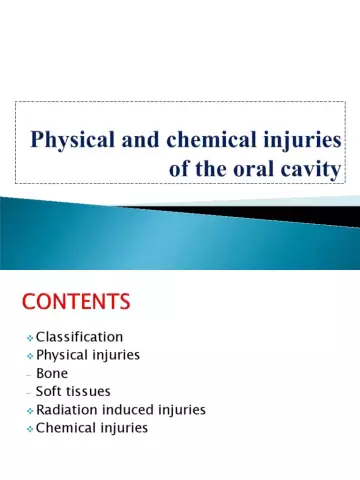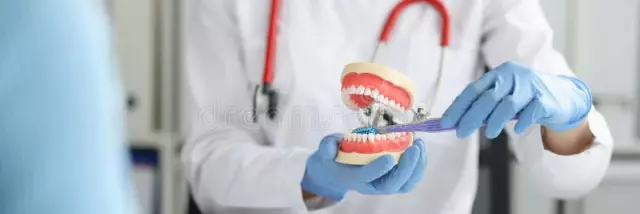- Author Rachel Wainwright [email protected].
- Public 2023-12-15 07:39.
- Last modified 2025-11-02 20:14.
Oral leukoplakia
The content of the article:
- Causes and risk factors
- Forms of the disease
- Disease stages
- Oral leukoplakia symptoms
- Diagnostics
- Treatment of oral leukoplakia
- Possible complications and consequences
- Forecast
- Prevention
Oral leukoplakia is a disease characterized by increased keratinization (hyperkeratosis) of a portion of the oral mucosa against the background of a constant exogenous stimulus, endogenous factors, or a combination thereof. In the pathological process, the mucous membranes of the lips, cheeks, hard and soft palate, the bottom of the mouth, and the tongue can be involved. The lesion has the appearance of a spot or several spots of white with clearly defined edges.

Oral leukoplakia is considered a precancerous disease
Oral leukoplakia is susceptible to malignant transformation and is considered a precancerous disease. The risk of malignancy is especially high when the lesion is located on the back of the tongue and / or at the bottom of the mouth.
The most susceptible to pathologies of the person from 30 to 70 years old, while leukoplakia of the oral cavity is almost twice as likely to be diagnosed in men than in women, which is associated with increased exposure to risk factors, such as work risks, smoking and alcohol abuse.
Causes and risk factors
The disease, as a rule, occurs against the background of constantly acting external stimuli (poorly fitted prostheses, fillings, sharp edges of decayed teeth), in addition, leukoplakia of the oral cavity can be due to endogenous (internal) causes.
Risk factors include:
- immunodeficiency states;
- lack of vitamins and other essential substances in the body (unbalanced diet);
- constant use of too cold or too hot, spicy, spicy food;
- inflammatory processes in the oral cavity;
- diseases of the gastrointestinal tract, which reduce the resistance of the mucous membrane to exogenous irritants;
- alcohol abuse, smoking;
- genetic factors;
- professional harm;
- malocclusion;
- constant electric currents of low strength and low voltage (if there are fillings and prostheses made of different metals in the oral cavity);
- taking certain medications;
- iron deficiency in the body;
- endocrine disorders;
- viral infections (especially human immunodeficiency virus, papillomavirus);
- excessive exposure to ultraviolet radiation;
- exposure to ionizing radiation.
At risk are elderly patients who take a large number of drugs of different pharmacological groups.

Oral leukoplakia can be caused by taking different medications
The combination of the action of several external (thermal, mechanical, chemical, etc.) and internal factors has the greatest damaging effect.
Forms of the disease
By the nature of the pathological process, the following forms of the disease are distinguished:
- simple leukoplakia without cellular atypia;
- flat leukoplakia;
- mild leukoplakia Pashkov;
- smokers' leukoplakia (nicotine leukoplakia, Tuppainer's leukoplakia);
- verrucous leukoplakia;
- erosive leukoplakia.
Simple leukoplakia without cellular atypia has a latent course and in most cases does not malignant, that is, it does not degenerate into a malignant tumor.
The flat form of leukoplakia is diagnosed most often. In most cases, patients do not experience discomfort in the oral cavity or do not pay attention to the rough area that appears, therefore, the disease is often discovered by chance during a routine examination.
With a mild form of leukoplakia of the oral cavity, lesions are localized mainly on the mucous membrane of the lips and cheeks, which is due to the constant biting of the oral mucosa. The mild form of leukoplakia is most often observed in young patients and in children.
Smokers' leukoplakia develops against the background of active tobacco smoking. The lesion is a diffuse thickening of the mucous membrane of the palate, it rarely undergoes malignancy and, as a rule, disappears after the patient quits smoking.
The verrucous form of oral leukoplakia is formed from a flat one in the absence of adequate therapy, as well as with continued exposure to an irritating factor on the mucous membrane. Differs in the appearance of nodules on the affected area (Latin verruca - wart). This form of leukoplakia is prone to malignant transformation.
Erosive leukoplakia of the oral cavity develops from verrucous. The risk of malignancy in this form is the highest - in some cases, erosive leukoplakia is considered as the initial stage of the tumor process.
Disease stages
Changes in the mucous membrane with leukoplakia of the oral cavity take place in three stages:
- Violations of the correct ratio of cellular elements (discomplexation) in the basal and suprabasal layers of the epidermis, slight cellular atypia is possible.
- The spread of the pathological process to all layers of the epidermis, keratinization of the epidermal layer, parakeratosis of the epithelium.
- Thickening of the epithelial layer, cellular polymorphism, keratinization of the epidermis, parakeratosis with foci of erosion.
Oral leukoplakia symptoms
Pathology usually debuts with a minor inflammatory process and / or edema in a small area of the oral mucosa, which then becomes uniformly keratinized. The lesions with leukoplakia of the oral cavity are single or multiple. When they appear, patients may experience itching, burning, a feeling of constriction in the affected areas, grope for a rough area with their tongue. In some cases, the disease is asymptomatic for a long time, remaining unnoticed.
With simple leukoplakia without cellular atypia, a thin whitish film or white compaction with clearly defined contours is found on the affected area of the mucous membrane. The flat form of leukoplakia of the oral cavity is usually not accompanied by unpleasant sensations, only in some cases the patient may complain of unusual dryness of the mucous membrane in a certain area. When the pathological site is located on the tongue, a weakening of taste sensations is noted.
With a mild form of the disease, compacted whitish areas of the oral mucosa are observed. The damaged surface can peel off, in some cases the morphological element is gray, and erosion is formed during injury.
Leukoplakia of smokers is manifested by lesions of the oral mucosa in the form of a dense white plaque with red dots. In this case, the "plaque" is not removed; it is tightly welded to the underlying tissues.
With the verrucous form of the disease, patients complain of discomfort in the oral cavity. The affected area is compacted, has a characteristic white color, is raised above the surface of the mucous membrane, and is easily injured when eating solid food.
The erosive form of the disease is characterized by the formation of erosions and cracks in the area of leukoplakia. With the localization of spots in the corners of the mouth or on the lateral surface of the tongue, patients experience difficulty opening their mouths, eating. The eroded areas are painful, painful sensations intensify when eating irritating food and drinks.
Symptoms of oral leukoplakia that may indicate malignancy are:
- erosion of the surface of the spot, the occurrence of non-healing ulcers;
- the appearance of a seal at the base of the morphological element;
- frequent bleeding of the affected area;
- a rapid increase in the size of the lesion;
- enlarged lymph nodes on the affected side.
Diagnostics
The primary diagnosis of the disease is based on data obtained from the collection of complaints and anamnesis, as well as an objective examination. To confirm the diagnosis and determine the stage of the process, a biopsy is performed - a microscopic tissue sample is taken from the affected area, followed by a histological examination.

Biopsy from the affected area confirms oral leukoplakia
Differential diagnosis of pathology with candidiasis, lichen planus, systemic lupus erythematosus, syphilis and malignant neoplasm is required.
Treatment of oral leukoplakia
The tactics of treating oral leukoplakia depends on the form and stage of the disease.
First of all, it is necessary to remove the source of constant irritation of the mucous membrane - replace the worn-out filling, adjust or replace the dentures, cure carious teeth. In the presence of endogenous factors affecting the development of oral leukoplakia, the underlying disease is treated. Measures are being taken to improve the health of the body and strengthen the immune system (quitting smoking, normalizing nutrition, etc.). In order to accelerate regeneration, the affected area of the mucous membrane is treated with an oil solution of vitamin A, rosehip oil, Carotolinum or other preparations for local use that stimulate reparative processes. For the treatment of simple and mild forms of leukoplakia, these measures are usually sufficient.

The affected areas of the mucous membrane are lubricated with vitamin A or other agents that stimulate reparative processes
With verrucous and erosive forms of the disease, surgical excision of the morphological element with mandatory histological analysis and subsequent dispensary observation of the patient may be required. In some cases, surgical removal can be replaced by cryodestruction.
Possible complications and consequences
Oral leukoplakia refers to precancerous conditions. The most dangerous complication of the disease can be a malignant degeneration of the damaged area of the oral mucosa.
Forecast
The initial stages of the disease, with timely diagnosis and adequate treatment, have a favorable prognosis; usually, for a complete cure, it is sufficient to eliminate the damaging exogenous factor. About 10% of all cases of pathology become malignant, that is, they are reborn into oral cancer.
Prevention
To prevent the development of oral leukoplakia, the following measures are necessary:
- regular check-ups at the dentist, timely sanitation of the oral cavity, high-quality prosthetics;
- timely treatment of diseases of the gastrointestinal tract;
- quitting bad habits, primarily smoking;
- compliance with the rules of personal hygiene, including oral hygiene;
- general strengthening of the body.
YouTube video related to the article:

Anna Aksenova Medical journalist About the author
Education: 2004-2007 "First Kiev Medical College" specialty "Laboratory Diagnostics".
The information is generalized and provided for informational purposes only. At the first sign of illness, see your doctor. Self-medication is hazardous to health!






